Aligning the Sustainable Development Goals in the Wine Industry: A Bibliometric Analysis
Abstract
1. Introduction
2. Materials and Methods
3. Results and Discussion
4. Conclusions
Author Contributions
Funding
Institutional Review Board Statement
Informed Consent Statement
Data Availability Statement
Conflicts of Interest
References
- Santini, C.; Cavicchi, A.; Casini, L. Sustainability in the wine industry: Key questions and research trends. Agric. Food Econ. 2013, 1, 9. [Google Scholar] [CrossRef]
- Szolnoki, G. A cross-national comparison of sustainability in the wine industry. J. Clean. Prod. 2013, 53, 243–251. [Google Scholar] [CrossRef]
- Gilinsky, A., Jr.; Newton, S.K.; Vega, R.F. Sustainability in the global wine industry: Concepts and cases. Agric. Agric. Sci. Procedia 2016, 8, 37–49. [Google Scholar] [CrossRef]
- Flores, S.S. What is sustainability in the wine world? A cross-country analysis of wine sustainability frameworks. J. Clean. Prod. 2018, 172, 2301–2312. [Google Scholar] [CrossRef]
- Ouvrard, S.; Jasimuddin, S.M.; Spiga, A. Does sustainability push to reshape business models? Evidence from the European wine industry. Sustainability 2020, 12, 2561. [Google Scholar] [CrossRef]
- Golicic, S.L. Changes in sustainability in the global wine industry. Int. J. Wine Bus. Res. 2022, 34, 392–409. [Google Scholar] [CrossRef]
- Gabzdylova, B.; Raffensperger, J.F.; Castka, P. Sustainability in the New Zealand wine industry: Drivers, stakeholders and practices. J. Clean. Prod. 2009, 17, 992–998. [Google Scholar] [CrossRef]
- Atkin, T.; Gilinsky, A.; Newton, S.K. Sustainability in the wine industry: Altering the competitive landscape. In Proceedings of the 6th AWBR International Conference, Talence, France, 9–10 June 2011; Bordeaux Management School: Talence, France, 2011; pp. 9–10. [Google Scholar]
- Dodds, R.; Graci, S.; Ko, S.; Walker, L. What drives environmental sustainability in the New Zealand wine industry? An examination of driving factors and practices. Int. J. Wine Bus. Res. 2013, 25, 164–184. [Google Scholar] [CrossRef]
- Bandinelli, R.; Acuti, D.; Fani, V.; Bindi, B.; Aiello, G. Environmental practices in the wine industry: An overview of the Italian market. Br. Food J. 2020, 122, 1625–1646. [Google Scholar] [CrossRef]
- Marco-Lajara, B.; Zaragoza-Sáez, P.C.; Martínez-Falcó, J.; Sánchez-García, E. Does green intellectual capital affect green innovation performance? Evidence from the Spanish wine industry. Br. Food J. 2022, 125, 1469–1487. [Google Scholar] [CrossRef]
- Marco-Lajara, B.; Zaragoza-Sáez, P.; Martínez-Falcó, J.; Ruiz-Fernández, L. The effect of green intellectual capital on green performance in the Spanish wine industry: A structural equation modeling approach. Complex. Financ. Econ. 2022, 2022, 6024077. [Google Scholar] [CrossRef]
- Marco-Lajara, B.; Seva-Larrosa, P.; Martínez-Falcó, J.; García-Lillo, F. Wine clusters and Protected Designations of Origin (PDOs) in Spain: An exploratory analysis. J. Wine Res. 2022, 33, 146–167. [Google Scholar] [CrossRef]
- Fuentes-Fernández, R.; Martínez-Falcó, J.; Sánchez-García, E.; Marco-Lajara, B. Does Ecological Agriculture Moderate the Relationship between Wine Tourism and Economic Performance? A Structural Equation Analysis Applied to the Ribera del Duero Wine Context. Agriculture 2022, 12, 2143. [Google Scholar] [CrossRef]
- Marco-Lajara, B.; Martínez-Falcó, J.; Millan-Tudela, L.A.; Sánchez-García, E. Analysis of the structure of scientific knowledge on wine tourism: A bibliometric analysis. Heliyon 2023, 9, e13363. [Google Scholar] [CrossRef] [PubMed]
- Marco-Lajara, B.; Martínez-Falcó, J.; Sánchez-García, E.; Millan-Tudela, L.A. Wine Tourism, Designations of Origin and Business Performance: An Analysis Applied to the Valencian Community Wine Industry. Businesses 2023, 3, 70–82. [Google Scholar] [CrossRef]
- Martínez-Falcó, J.; Sánchez-García, E.; Millan-Tudela, L.A.; Marco-Lajara, B. The Role of Green Agriculture and Green Supply Chain Management in the Green Intellectual Capital–Sustainable Performance Relationship: A Structural Equation Modeling Analysis Applied to the Spanish Wine Industry. Agriculture 2023, 13, 425. [Google Scholar] [CrossRef]
- Falcó, J.M.; Marco-Lajara, B.; Zaragoza-Sáez, P.; Sánchez-García, E. Vino, Turismo y COVID-19: El impacto de la COVID-19 en las Rutas del Vino de España. PASOS Rev. Tur. Patrim. Cult. 2023, 21, 83–97. [Google Scholar] [CrossRef]
- Alonso, A.; Liu, Y. Old wine region, new concept and sustainable development: Winery entrepreneurs’ perceived benefits from wine tourism on Spain’s Canary Islands. J. Sustain. Tour. 2012, 20, 991–1009. [Google Scholar] [CrossRef]
- Pomarici, E.; Vecchio, R. Will sustainability shape the future wine market? Wine Econ. Policy 2019, 8, 1–4. [Google Scholar] [CrossRef]
- Knight, H.; Megicks, P.; Agarwal, S.; Leenders, M. Firm resources and the development of environmental sustainability among small and medium-sized enterprises: Evidence from the Australian wine industry. Bus. Strategy Environ. 2019, 28, 25–39. [Google Scholar] [CrossRef]
- Maicas, S.; Mateo, J. Sustainability of wine production. Sustainability 2020, 12, 559. [Google Scholar] [CrossRef]
- Mio, C.; Panfilo, S.; Blundo, B. Sustainable development goals and the strategic role of business: A systematic literature review. Bus. Strategy Environ. 2020, 29, 3220–3245. [Google Scholar] [CrossRef]
- García-Sánchez, I.; Rodríguez-Ariza, L.; Aibar-Guzmán, B.; Aibar-Guzmán, C. Do institutional investors drive corporate transparency regarding business contribution to the sustainable development goals? Bus. Strategy Environ. 2020, 29, 2019–2036. [Google Scholar] [CrossRef]
- Ramos, J.S.; Ferreira, A.F. Techno-economic analysis and life cycle assessment of olive and wine industry co-products valorisation. Renew. Sustain. Energy Rev. 2022, 155, 111929. [Google Scholar] [CrossRef]
- Pougnet, S.; Martin-Rios, C.; Pasamar, S. Keg wine technology as a service innovation for sustainability in the foodservice industry. J. Clean. Prod. 2022, 360, 132–145. [Google Scholar] [CrossRef]
- Pizzol, L.; Luzzani, G.; Criscione, P.; Barro, L.; Bagnoli, C.; Capri, E. The Role of Corporate Social Responsibility in the Wine Industry: The Case Study of Veneto and Friuli Venezia Giulia. Sustainability 2021, 13, 13230. [Google Scholar] [CrossRef]
- Merino-Aranda, A.; Castillejo-González, I.L.; Velo-Gala, A.; de Paula Montes-Tubío, F.; Mesas-Carrascosa, F.J.; Triviño-Tarradas, P. Strengthening efforts to protect and safeguard the industrial cultural heritage in montilla-moriles (Pdo). characterisation of historic wineries. Sustainability 2021, 13, 5791. [Google Scholar] [CrossRef]
- Kariyapperuma, N.; Collins, E. Family logics and environmental sustainability: A study of the New Zealand wine industry. Bus. Strategy Environ. 2021, 30, 3626–3650. [Google Scholar] [CrossRef]
- Aragón-Correa, J.A.; de la Torre-Ruiz, J.M.; Vidal-Salazar, M.D. Agglomerations around natural resources in the hospitality industry: Balancing growth with the sustainable development goals. BRQ Bus. Res. Q. 2022, 26, 11–26. [Google Scholar] [CrossRef]
- Trigo, A.; Marta-Costa, A.; Fragoso, R. Improving sustainability assessment: A context-oriented classification analysis for the wine industry. Land Use Policy 2023, 126, 106551. [Google Scholar] [CrossRef]
- Câmara, J.S.; Lourenço, S.; Silva, C.; Lopes, A.; Andrade, C.; Perestrelo, R. Exploring the potential of wine industry by-products as source of additives to improve the quality of aquafeed. Microchem. J. 2020, 155, 104758. [Google Scholar] [CrossRef]
- Spraul, K.; Höfert, A. Governance for Sustainability: Patterns of Regulation and Self-Regulation in the German Wine Industry. Sustainability 2021, 13, 3140. [Google Scholar] [CrossRef]
- Tasic, M. Preserving Agriculture through Wine: Examining the Opportunity for Ontario’s Wine Industry to Pioneer Agricultural Resilience in The Face of Climate Change; OCAD University: Toronto, ON, Canada, 2019; Available online: https://openresearch.ocadu.ca/id/eprint/2838/ (accessed on 15 January 2023).
- Gomes, M.J.; Sousa, A.; Novas, J.; Jordão, R.V.D. Environmental sustainability in viticulture as a balanced scorecard perspective of the wine industry: Evidence for the Portuguese region of Alentejo. Sustainability 2021, 13, 10144. [Google Scholar] [CrossRef]
- Mozas-Moral, A.; Fernández-Uclés, D.; Medina-Viruel, M.J.; Bernal-Jurado, E. The role of the SDGs as enhancers of the performance of Spanish wine cooperatives. Technol. Forecast. Soc. Chang. 2021, 173, 121176. [Google Scholar] [CrossRef]
- Clarivate. Web of Science Core Collection 2022. Available online: https://clarivate.com/webofsciencegroup/solutions/web-ofscience-core-collection/ (accessed on 2 February 2023).
- Clarivate. Operadores de Búsqueda. 2021. Available online: http://webofscience.help.clarivate.com/es-es/Content/search-operators.html (accessed on 2 February 2023).
- Clarivate. Reglas de Búsqueda. 2021. Available online: http://webofscience.help.clarivate.com/es-es/Content/search-rules.htm (accessed on 2 February 2023).
- Page, M.; McKenzie, J.; Bossuyt, P.; Boutron, I.; Hoffmann, T.; Mulrow, C.; Moher, D. The PRISMA 2020 statement: An updated guideline for reporting systematic reviews. Int. J. Surg. 2021, 88, 105906. [Google Scholar] [CrossRef]
- Moher, D.; Liberati, A.; Tetzlaff, J.; Altman, D.; Prisma Group. Preferred reporting items for systematic reviews and meta-analyses: The PRISMA statement. Int. J. Surg. 2010, 8, 336–341. [Google Scholar] [CrossRef]
- Rethlefsen, M.; Kirtley, S.; Waffenschmidt, S.; Ayala, A.; Moher, D.; Page, M.; Koffel, J. PRISMA-S: An extension to the PRISMA statement for reporting literature searches in systematic reviews. Syst. Rev. 2021, 10, 39. [Google Scholar] [CrossRef]
- Ortiz-Martínez, V.M.; Andreo-Martinez, P.; Garcia-Martinez, N.; de los Ríos, A.P.; Hernández-Fernández, F.J.; Quesada-Medina, J. Approach to biodiesel production from microalgae under supercritical conditions by the PRISMA method. Fuel Process. Technol. 2019, 191, 211–222. [Google Scholar] [CrossRef]
- Yepes-Nuñez, J.J.; Urrutia, G.; Romero-Garcia, M.; Alonso-Fernandez, S. The PRISMA 2020 statement: An updated guideline for reporting systematic reviews. Rev. Esp. Cardiol. 2021, 74, 790–799. [Google Scholar]
- Ardern, C.L.; Büttner, F.; Andrade, R.; Weir, A.; Ashe, M.C.; Holden, S.; Impellizzeri, F.M.; Delahunt, E.; Dijkstra, H.P.; Mathieson, S.; et al. Implementing the 27 PRISMA 2020 statement items for systematic reviews in the sport and exercise medicine, musculoskeletal rehabilitation and sports science fields: The persist (implementing Prisma in exercise, rehabilitation, sport medicine and sports science) guidance. Br. J. Sport. Med. 2022, 56, 175–195. [Google Scholar] [CrossRef]
- Arya, S.; Kaji, A.H.; Boermeester, M.A. PRISMA reporting guidelines for meta-analyses and systematic reviews. JAMA Surg. 2021, 156, 789–790. [Google Scholar] [CrossRef] [PubMed]
- Haddaway, N.R.; Page, M.J.; Pritchard, C.C.; McGuinness, L.A. PRISMA2020: An R package and Shiny app for producing PRISMA 2020-compliant flow diagrams, with interactivity for optimised digital transparency and Open Synthesis. Campbell Syst. Rev. 2022, 18, e1230. [Google Scholar] [CrossRef] [PubMed]
- O’Dea, R.E.; Lagisz, M.; Jennions, M.D.; Koricheva, J.; Noble, D.W.; Parker, T.H.; Gurevitch, J.; Page, M.J.; Stewart, G.; Moher, D.; et al. Preferred reporting items for systematic reviews and meta-analyses in ecology and evolutionary biology: A PRISMA extension. Biol. Rev. 2021, 96, 1695–1722. [Google Scholar] [CrossRef] [PubMed]
- ElAlfy, A.; Palaschuk, N.; El-Bassiouny, D.; Wilson, J.; Weber, O. Scoping the evolution of corporate social responsibility (CSR) research in the sustainable development goals (SDGs) era. Sustainability 2020, 12, 5544. [Google Scholar] [CrossRef]
- Castro, G.; Fernandez, M.; Colsa, A. Unleashing the convergence amid digitalization and sustainability towards pursuing the Sustainable Development Goals (SDGs): A holistic review. J. Clean. Prod. 2021, 280, 122204. [Google Scholar] [CrossRef]
- Lagoarde-Segot, T. Financing the sustainable development goals. Sustainability 2020, 12, 2775. [Google Scholar] [CrossRef]
- Masuda, H.; Okitasari, M.; Morita, K.; Katramiz, T.; Shimizu, H.; Kawakubo, S.; Kataoka, Y. SDGs mainstreaming at the local level: Case studies from Japan. Sustain. Sci. 2021, 16, 1539–1562. [Google Scholar] [CrossRef]
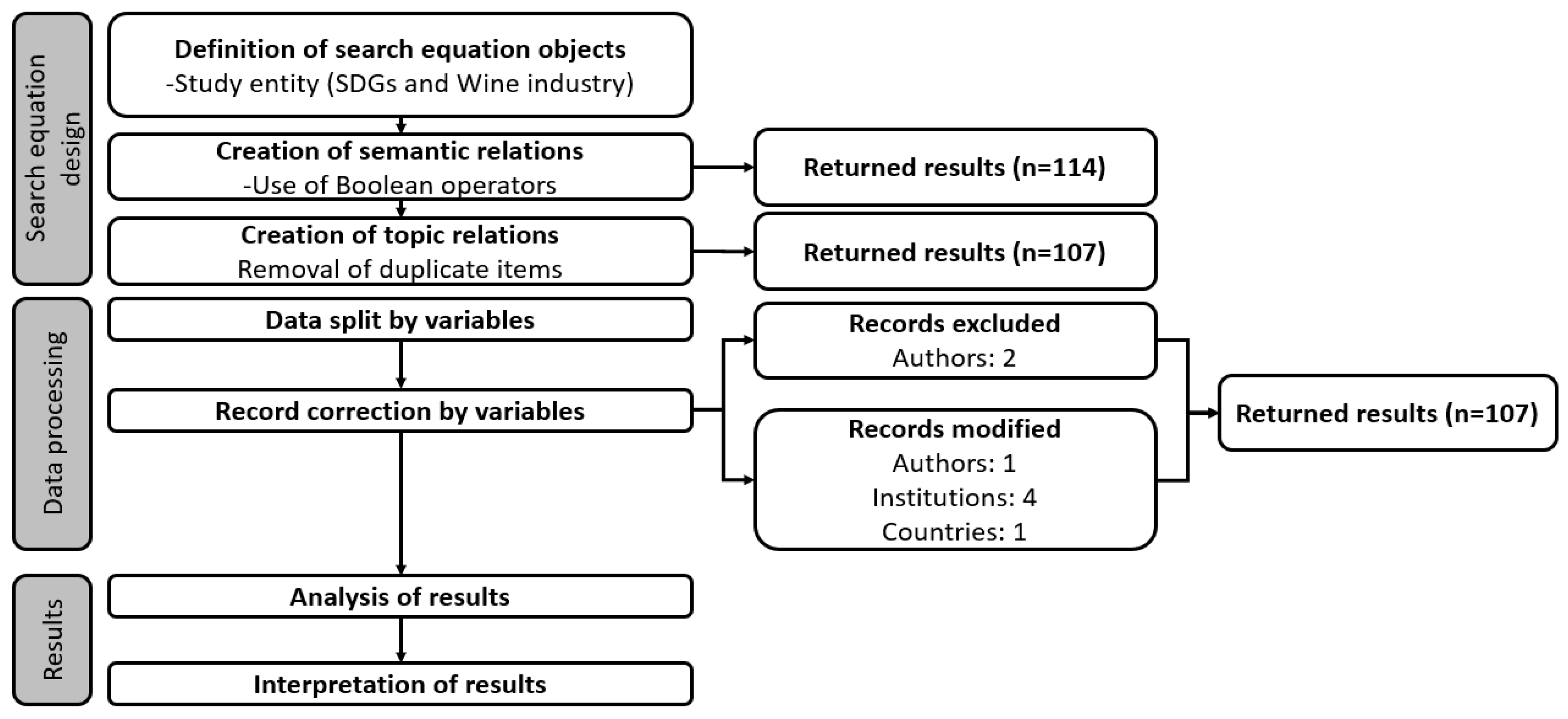
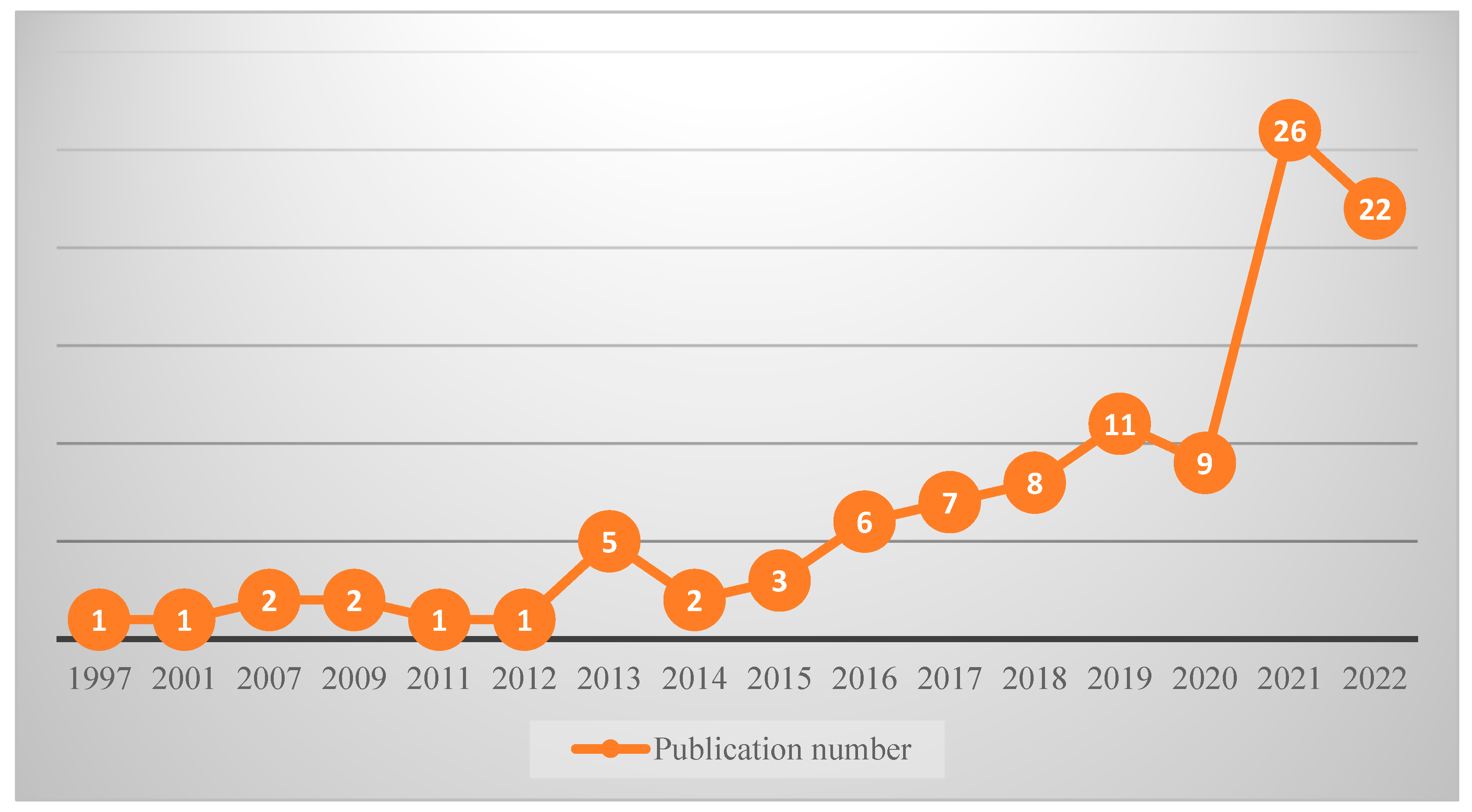

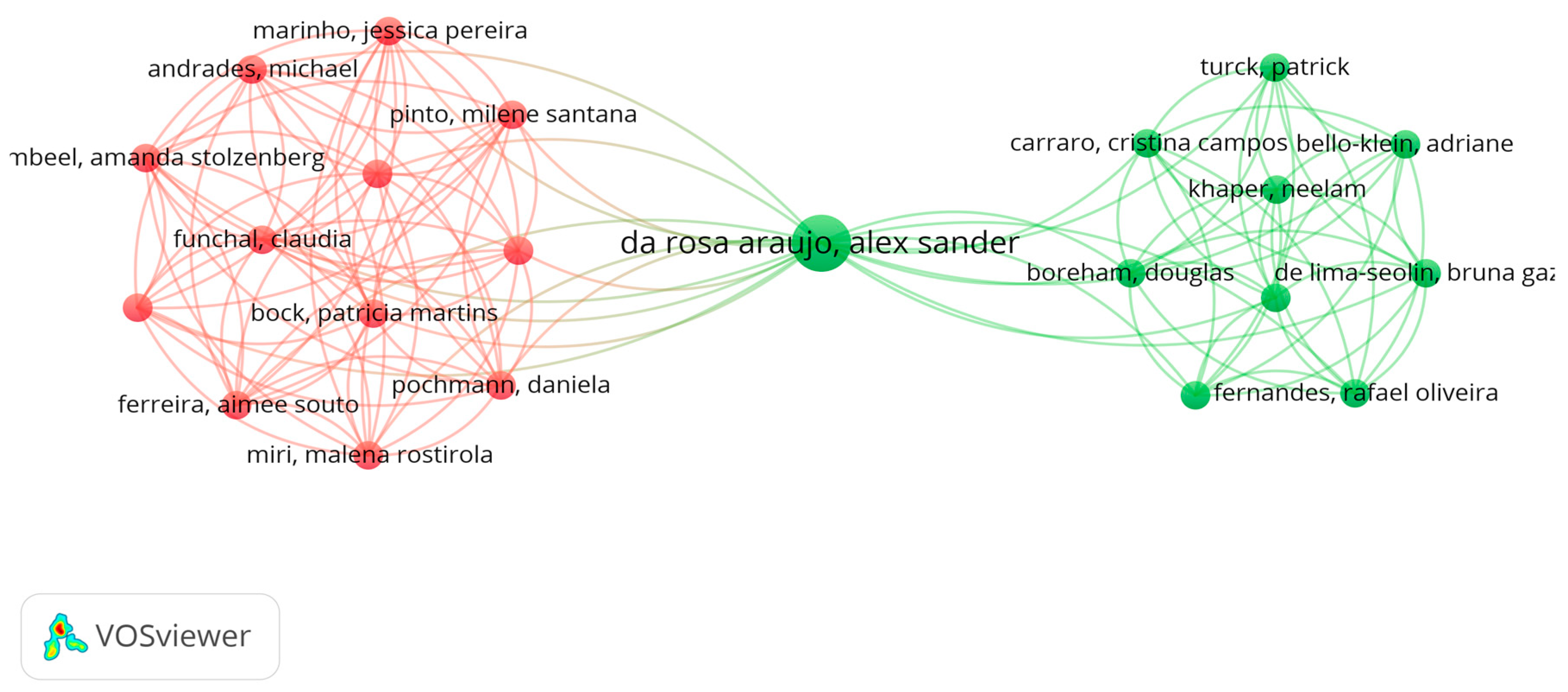
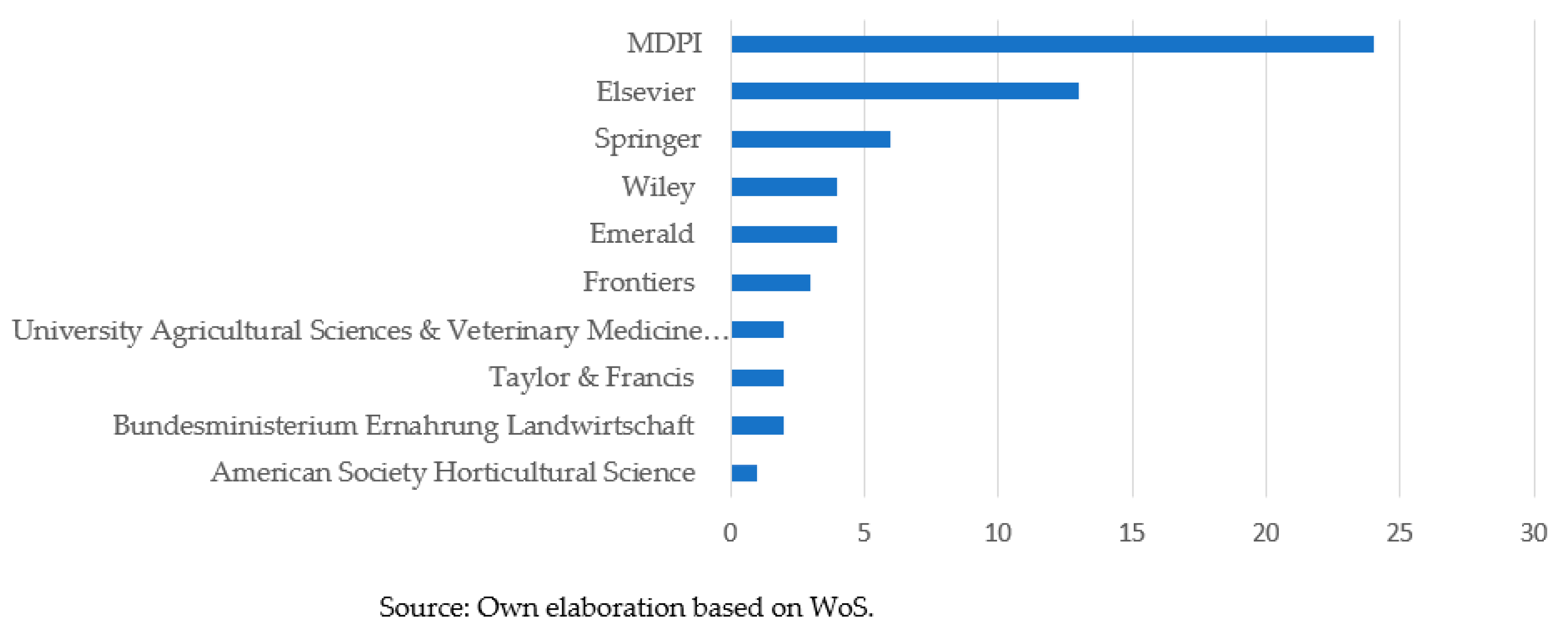
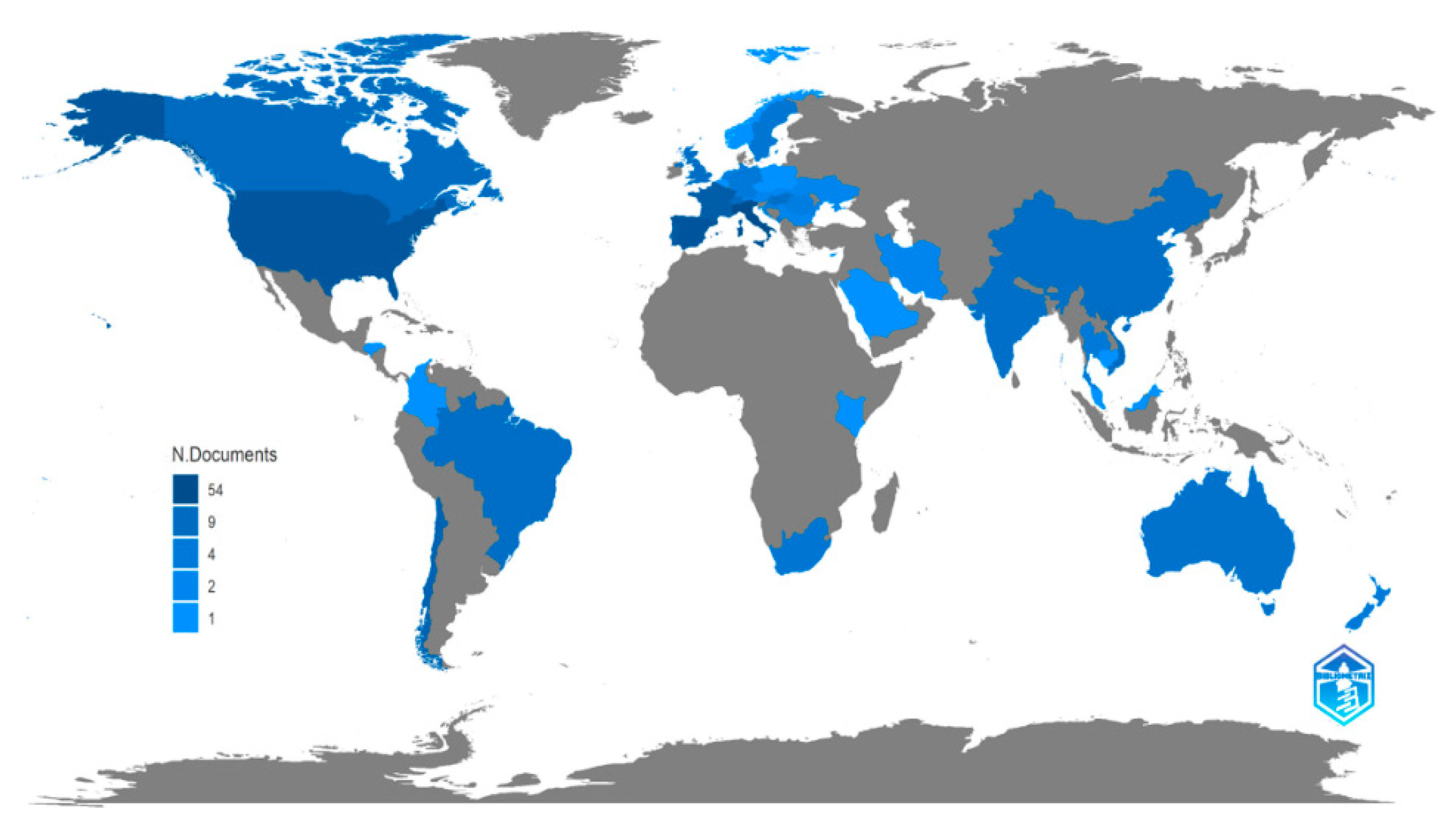
| No. | WOS Categories | Documents | No. | WOS Categories | Records |
|---|---|---|---|---|---|
| 1 | Environmental Sciences | 28 | 16 | Entomology | 3 |
| 2 | Environmental Studies | 20 | 17 | Plant Sciences | 3 |
| 3 | Green Sustainable Science Technology | 20 | 18 | Biodiversity Conservation | 2 |
| 4 | Food Science Technology | 15 | 19 | Business Finance | 2 |
| 5 | Horticulture | 8 | 20 | Engineering Chemical | 2 |
| 6 | Agriculture Multidisciplinary | 7 | 21 | Forestry | 2 |
| 7 | Agronomy | 7 | 22 | Geography | 2 |
| 8 | Business | 7 | 23 | Geosciences Multidisciplinary | 2 |
| 9 | Agricultural Economics Policy | 5 | 24 | History Philosophy Of Science | 2 |
| 10 | Economics | 5 | 25 | Hospitality Leisure Sport Tourism | 2 |
| 11 | Management | 5 | 26 | Instruments Instrumentation | 2 |
| 12 | Agricultural Engineering | 4 | 27 | Microbiology | 2 |
| 13 | Biotechnology Applied Microbiology | 4 | 28 | Nutrition Dietetics | 2 |
| 14 | Automation Control Systems | 3 | 29 | Public Environmental Occupational Health | 2 |
| 15 | Engineering Environmental | 3 | 30 | Regional Urban Planning | 2 |
| Author | Registers | Citations | Ratio | Institution | Country | |
|---|---|---|---|---|---|---|
| 1 | Alex Sander da Rosa Araujo | 3 | 13 | 6, 5 | Universidade Federal do Rio Grande do Sul | Brazil |
| 2 | Patricio Arce-Johnson | 2 | 39 | 19, 5 | Pontificia Universidad Catolica de Chile | Chile |
| 3 | Artemi Cerda | 2 | 97 | 48, 5 | University of Valencia | Spain |
| 4 | Monica Cooper | 2 | 105 | 52, 5 | University of California System | USA |
| 5 | Kent Daane | 2 | 105 | 52, 5 | University of California Berkeley | USA |
| 6 | Concetta Ferrara | 2 | 3 | 1, 5 | University of Macerata | Italy |
| 7 | Elisa Giacosa | 2 | 16 | 8 | University of Turin | Italy |
| 8 | Barbara Iannone | 2 | 1 | 0, 5 | University of Chieti-Pescara | Italy |
| 9 | Kimberly Nicholas | 2 | 105 | 52, 5 | Lund University | Sweden |
| 10 | Jesús Rodrigo-Comino | 2 | 31 | 15, 5 | University of Granada | Spain |
| 11 | Thelma Zulfawu Abu | 1 | 4 | 4 | University Toronto Mississauga | USA |
| 12 | Abbas Afshar | 1 | 1 | 1 | Iran University Science & Technology | Iran |
| 13 | Fahad Al-Asmari | 1 | 72 | 72 | King Faisal University | Saudi Arabia |
| 14 | Alberto Mazzoni | 1 | 1 | 1 | University of Brescia | Italy |
| 15 | Eneka Albizu | 1 | 0 | 0 | University of Basque Country | Spain |
| 16 | Chiara Aleffi | 1 | 2 | 2 | University of Macerata | Italy |
| 17 | Rodrigo Almeida | 1 | 99 | 99 | Universidade Estadual Paulista | Brazil |
| 18 | Anil Kumar Anal | 1 | 8 | 8 | Asian Institute of Technology | Thailand |
| 19 | Emiliano Anceschi | 1 | 1 | 1 | Gruppo Filippetti SpA | Italy |
| 20 | Michael Andrades | 1 | 0 | 0 | Universidade Federal do Rio Grande do Sul | Brazil |
| 21 | Eleonora Annunziata | 1 | 76 | 76 | Scuola Superiore Sant’Anna | Italy |
| 22 | Sylvia Anton | 1 | 0 | 0 | Universite de Rennes | France |
| 23 | Felipe Aquea | 1 | 39 | 39 | University of Adolfo Ibanez | Chile |
| 24 | Vicent Arbona | 1 | 36 | 36 | Universitat Jaume I | Spain |
| 25 | Maria Arroyo-Hernandez | 1 | 6 | 6 | University of Francisco de Vitoria | Spain |
| 26 | Vanessa Assumma | 1 | 0 | 0 | Polytechnic University of Turin | Italy |
| 27 | Harshal Avinashe | 1 | 0 | 0 | Lovely Professional University | India |
| 28 | Karthik Sajith Babu | 1 | 31 | 31 | Kansas State University | USA |
| 29 | Lorenzo Baglieri | 1 | 0 | 0 | Polytechnic University of Turin | Italy |
| 30 | Bruno Bagnoli | 1 | 2 | 2 | Tuscia University | Italy |
| Institutions | Records | Region |
|---|---|---|
| University of Valencia | 5 | Spain |
| INRAE | 4 | France |
| Lund University | 4 | Sweden |
| University of California System | 4 | USA |
| University of Turin | 4 | Italy |
| Catholic University of the Sacred Heart | 3 | Italy |
| University of Cordoba | 3 | Italy |
| University of Lisboa | 3 | Spain |
| University of California Berkeley | 3 | USA |
| University of Tras os Montes Alto Douro | 3 | Portugal |
| Beijing Forestry University | 2 | China |
| Centre National de la Recherche Scientifique | 2 | France |
| CIRAD | 2 | France |
| Fondazione Edmund Mach | 2 | Italy |
| Annunzio University of Chieti Pescara | 2 | Italy |
| L’institut Agro | 2 | France |
| Polytechnic University of Turin | 2 | Italy |
| Pontificia Universidad Catolica de Chile | 2 | Chile |
| Swiss Federal Research Station Agroscope | 2 | Switzerland |
| Udice French Research Universities | 2 | France |
| United States Department of Agriculture | 2 | USA |
| Universidad Autonoma de Chile | 2 | Chile |
| University of Castilla La Mancha | 2 | Spain |
| University of Malaga | 2 | Spain |
| Polytechnic University of Madrid | 2 | Spain |
| Universidade da Beira Interior | 2 | Portugal |
| Universidade Federal do Rio Grande do Sul | 2 | Brazil |
| Universitat Trier | 2 | Germany |
| University of Bologna | 2 | Italy |
| University of California Davis | 2 | USA |
| Journals | Records | Highest 2021 JIF Quartile | Publishing Houses |
|---|---|---|---|
| Sustainability | 14 | Q2 | MDPI |
| Journal of Cleaner Production | 3 | Q1 | Elsevier |
| Science of the Total Environment | 3 | Q1 | Elsevier |
| Berichte Uber Landwirtschaft | 2 | Q4 | Bundesministerium Ernahrung Landwirtschaft |
| British Food Journal | 2 | Q2 | Emerald |
| Foods | 2 | Q1 | MDPI |
| International Journal of Environmental Research and Public Health | 2 | Q1 | MDPI |
| International Journal of Wine Business Research | 2 | - | Emerald |
| Aestimum | 1 | Q3 | Firenze University Press |
| Agriculture and Human Values | 1 | Q1 | Elsevier |
| Agriculture | 1 | Q1 | MDPI |
| Applied Sciences | 1 | Q2 | MDPI |
| Arthropod Structure Development | 1 | Q2 | Elsevier |
| Australian Journal of Grape and Wine Research | 1 | Q1 | Wiley |
| Baltic Journal of Economic Studies | 1 | - | Baltic Economic Studies |
| Birth Defects Research | 1 | Q3 | Wiley |
| Chemometrics and Intelligent Laboratory Systems | 1 | Q1 | Elsevier |
| CIRIEC Espana. Revista de Economia Publica Social y Cooperativa | 1 | - | CIRIEC |
| Computers and Electronics in Agriculture | 1 | Q1 | Elsevier |
| ECO MONT Journal on Protected Mountain Areas Research | 1 | Q4 | Austrian Academy Sciences Press |
| Ekonomika Poljoprivreda Economics of Agriculture | 1 | - | Balkan Scientific Association Agrarian Economists |
| European Journal of Sustainable Development | 1 | - | European Center Sustainable Development |
| Fermentation | 1 | Q2 | MDPI |
| Frontiers in Microbiology | 1 | Q1 | Frontiers |
| Frontiers in Nutrition | 1 | Q1 | Frontiers |
| Frontiers in Plant Science | 1 | Q1 | Frontiers |
| Hortscience | 1 | Q2 | American Society Horticultural Science |
| Industrial Crops and Products | 1 | Q1 | Elsevier |
| Insects | 1 | Q1 | MDPI |
| International Entrepreneurship and Management Journal | 1 | Q2 | Springer |
Disclaimer/Publisher’s Note: The statements, opinions and data contained in all publications are solely those of the individual author(s) and contributor(s) and not of MDPI and/or the editor(s). MDPI and/or the editor(s) disclaim responsibility for any injury to people or property resulting from any ideas, methods, instructions or products referred to in the content. |
© 2023 by the authors. Licensee MDPI, Basel, Switzerland. This article is an open access article distributed under the terms and conditions of the Creative Commons Attribution (CC BY) license (https://creativecommons.org/licenses/by/4.0/).
Share and Cite
Martínez-Falcó, J.; Martínez-Falcó, J.; Marco-Lajara, B.; Sánchez-García, E.; Visser, G. Aligning the Sustainable Development Goals in the Wine Industry: A Bibliometric Analysis. Sustainability 2023, 15, 8172. https://doi.org/10.3390/su15108172
Martínez-Falcó J, Martínez-Falcó J, Marco-Lajara B, Sánchez-García E, Visser G. Aligning the Sustainable Development Goals in the Wine Industry: A Bibliometric Analysis. Sustainability. 2023; 15(10):8172. https://doi.org/10.3390/su15108172
Chicago/Turabian StyleMartínez-Falcó, Joaquín, Javier Martínez-Falcó, Bartolomé Marco-Lajara, Eduardo Sánchez-García, and Gustav Visser. 2023. "Aligning the Sustainable Development Goals in the Wine Industry: A Bibliometric Analysis" Sustainability 15, no. 10: 8172. https://doi.org/10.3390/su15108172
APA StyleMartínez-Falcó, J., Martínez-Falcó, J., Marco-Lajara, B., Sánchez-García, E., & Visser, G. (2023). Aligning the Sustainable Development Goals in the Wine Industry: A Bibliometric Analysis. Sustainability, 15(10), 8172. https://doi.org/10.3390/su15108172







